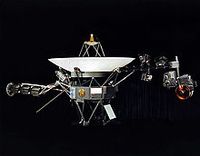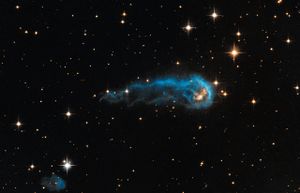وسط بين نجمي

الوسط بين نجمي Interstellar medium تطلق كلمة الوسط بين النجوم على الحيز الكامن بين النجوم في المجرة وتشمل دراسته في الفيزياء الفلكية على معرفة طبيعة الجزيئات المبعثرة بشكل عشوائي في الفضاء بين النجوم وبين المجرات.
Voyager 1 reached the ISM on August 25, 2012, making it the first artificial object from Earth to do so. Interstellar plasma and dust will be studied until the mission's end in 2025. Its twin, Voyager 2 entered the ISM in November 2018.

Interstellar matter
Table 1 shows a breakdown of the properties of the components of the ISM of the Milky Way.
| Component | Fractional volume |
Scale height (pc) |
Temperature (K) |
Density (particles/cm3) |
State of hydrogen | Primary observational techniques |
|---|---|---|---|---|---|---|
| Molecular clouds | < 1% | 80 | 10–20 | 102–106 | molecular | Radio and infrared molecular emission and absorption lines |
| Cold Neutral Medium (CNM) | 1–5% | 100–300 | 50–100 | 20–50 | neutral atomic | H I 21 cm line absorption |
| Warm Neutral Medium (WNM) | 10–20% | 300–400 | 6000–10000 | 0.2–0.5 | neutral atomic | H I 21 cm line emission |
| Warm Ionized Medium (WIM) | 20–50% | 1000 | 8000 | 0.2–0.5 | ionized | Hα emission and pulsar dispersion |
| H II regions | < 1% | 70 | 8000 | 102–104 | ionized | Hα emission and pulsar dispersion |
| Coronal gas Hot Ionized Medium (HIM) |
30–70% | 1000–3000 | 106–107 | 10−4–10−2 | ionized (metals also highly ionized) |
X-ray emission; absorption lines of highly ionized metals, primarily in the ultraviolet |
The three-phase model
Field, Goldsmith & Habing (1969) put forward the static two phase equilibrium model to explain the observed properties of the ISM. Their modeled ISM consisted of a cold dense phase (T < 300 K), consisting of clouds of neutral and molecular hydrogen, and a warm intercloud phase (T ~ 104 K), consisting of rarefied neutral and ionized gas. McKee & Ostriker (1977) added a dynamic third phase that represented the very hot (T ~ 106 K) gas which had been shock heated by supernovae and constituted most of the volume of the ISM. These phases are the temperatures where heating and cooling can reach a stable equilibrium. Their paper formed the basis for further study over the past three decades. However, the relative proportions of the phases and their subdivisions are still not well known.[1]
The atomic hydrogen model
This model takes into account only atomic hydrogen : Temperature larger than 3000 K breaks molecules, lower than 50 000 K leaves atoms in their ground state. It is assumed that influence of other atoms (He ...) is negligible. Pressure is assumed very low, so that durations of free paths of atoms are larger than the ~ 1 nanosecond duration of light pulses which make ordinary, temporally incoherent light .
Structures
Interstellar extinction
Heating and cooling
Heating mechanisms
Gas heating via grain-gas collisions is dominant deep in giant molecular clouds (especially at high densities). Far infrared radiation penetrates deeply due to the low optical depth. Dust grains are heated via this radiation and can transfer thermal energy during collisions with the gas. A measure of efficiency in the heating is given by the accommodation coefficient:
where T is the gas temperature, Td the dust temperature, and T2 the post-collision temperature of the gas atom or molecule. This coefficient was measured by (Burke & Hollenbach 1983) as α = 0.35.
- Other heating mechanisms
- A variety of macroscopic heating mechanisms are present including:
- Gravitational collapse of a cloud
- Supernova explosions
- Stellar winds
- Expansion of H II regions
- Magnetohydrodynamic waves created by supernova remnants
Cooling mechanisms
History of knowledge of interstellar space
See also
Notes
- ^ أ ب خطأ استشهاد: وسم
<ref>غير صحيح؛ لا نص تم توفيره للمراجع المسماةFerriere2001 - ^ "The Pillars of Creation Revealed in 3D". European Southern Observatory. 30 April 2015. Retrieved 14 June 2015.
- ^ "A geyser of hot gas flowing from a star". ESA/Hubble Press Release. Retrieved 3 July 2012.
- ^ "Hubble sees a cosmic caterpillar". Image Archive. ESA/Hubble. Retrieved 9 September 2013.
References
- Bacon, Francis (1626), Sylva (3545 ed.)
- Beals, C. S. (1936), "On the interpretation of interstellar lines", Monthly Notices of the Royal Astronomical Society 96: 661, doi:, Bibcode: 1936MNRAS..96..661B
- Birkeland, Kristian (1913), "Polar Magnetic Phenomena and Terrella Experiments", The Norwegian Aurora Polaris Expedition, 1902-03 (section 2), New York: Christiania (now Oslo), H. Aschelhoug & Co., pp. 720, https://archive.org/details/norwegianaurorap01chririch out-of-print, full text online
- Boyle, Robert (1674), The Excellency of Theology Compar'd with Natural Philosophy, ii. iv., pp. 178
- Burke, J. R.; Hollenbach, D.J. (1983), "The gas-grain interaction in the interstellar medium – Thermal accommodation and trapping", Astrophysical Journal 265: 223, doi:, Bibcode: 1983ApJ...265..223B
- Dyson, J. (1997), Physics of the Interstellar Medium, London: Taylor & Francis
- Field, G. B.; Goldsmith, D. W.; Habing, H. J. (1969), "Cosmic-Ray Heating of the Interstellar Gas", Astrophysical Journal 155: L149, doi:, Bibcode: 1969ApJ...155L.149F
- Ferriere, K. (2001), "The Interstellar Environment of our Galaxy", Reviews of Modern Physics 73 (4): 1031–1066, doi:, Bibcode: 2001RvMP...73.1031F
- Haffner, L. M.; Reynolds, R. J.; Tufte, S. L.; Madsen, G. J.; Jaehnig, K. P.; Percival, J. W. (2003), "The Wisconsin Hα Mapper Northern Sky Survey", Astrophysical Journal Supplement 145 (2): 405, doi:, Bibcode: 2003ApJS..149..405H. The Wisconsin Hα Mapper is funded by the National Science Foundation.
- Heger, Mary Lea (1919), "Stationary Sodium Lines in Spectroscopic Binaries", Publications of the Astronomical Society of the Pacific 31 (184): 304, doi:, Bibcode: 1919PASP...31..304H
- Lamb G. L. Jr. “Analytical description of ultra-short optical pulse propagation in a resonant medium”, Rev. Mod. Phys., 43, 99-124.
- Lequeux, J. The Interstellar Medium. Springer 2005.
- McKee, C. F.; Ostriker, J. P. (1977), "A theory of the interstellar medium – Three components regulated by supernova explosions in an inhomogeneous substrate", Astrophysical Journal 218: 148, doi:, Bibcode: 1977ApJ...218..148M
- Patterson, Robert Hogarth (1862), "Colour in nature and art", Essays in History and Art 10 Reprinted from Blackwood's Magazine.
- Pickering, W. H. (1912), "The Motion of the Solar System relatively to the Interstellar Absorbing Medium", Monthly Notices of the Royal Astronomical Society 72: 740, doi:, Bibcode: 1912MNRAS..72..740P
- Spitzer, L. (1978), Physical Processes in the Interstellar Medium, Wiley, ISBN 0-471-29335-0
- Stone, E. C.; Cummings, A. C.; McDonald, F. B.; Heikkila, B. C.; Lal, N.; Webber, W. R. (2005), "Voyager 1 Explores the Termination Shock Region and the Heliosheath Beyond", Science 309 (5743): 2017–20, doi:, PMID 16179468, Bibcode: 2005Sci...309.2017S
- Thorndike, S. L. (1930), "Interstellar Matter", Publications of the Astronomical Society of the Pacific 42 (246): 99, doi:, Bibcode: 1930PASP...42...99T, http://articles.adsabs.harvard.edu//full/seri/PASP./0042//0000099.000.html
- Yan, Y. X.; Gamble, E.B. Jr.; Nelson K. A. (1985), “Impulsive Stimulated Scattering: General Importance in Femto-second Laser Pulse Interactions with Matter and Spectroscopic Applications”, J. Chem. Phys., 83, 3591–5399.





